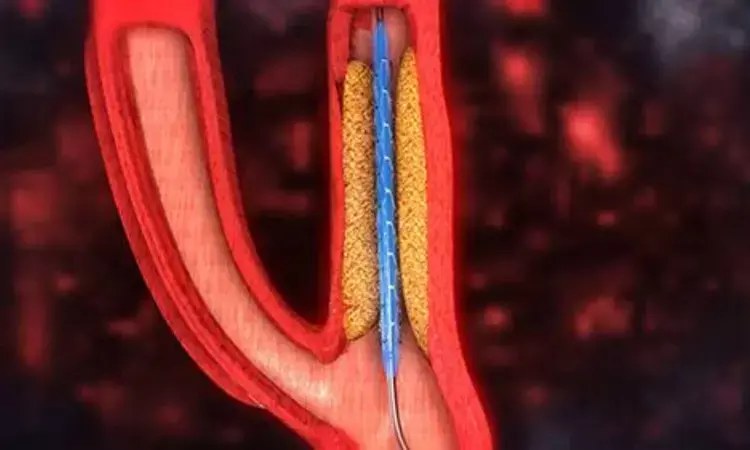- Home
- Medical news & Guidelines
- Anesthesiology
- Cardiology and CTVS
- Critical Care
- Dentistry
- Dermatology
- Diabetes and Endocrinology
- ENT
- Gastroenterology
- Medicine
- Nephrology
- Neurology
- Obstretics-Gynaecology
- Oncology
- Ophthalmology
- Orthopaedics
- Pediatrics-Neonatology
- Psychiatry
- Pulmonology
- Radiology
- Surgery
- Urology
- Laboratory Medicine
- Diet
- Nursing
- Paramedical
- Physiotherapy
- Health news
- Fact Check
- Bone Health Fact Check
- Brain Health Fact Check
- Cancer Related Fact Check
- Child Care Fact Check
- Dental and oral health fact check
- Diabetes and metabolic health fact check
- Diet and Nutrition Fact Check
- Eye and ENT Care Fact Check
- Fitness fact check
- Gut health fact check
- Heart health fact check
- Kidney health fact check
- Medical education fact check
- Men's health fact check
- Respiratory fact check
- Skin and hair care fact check
- Vaccine and Immunization fact check
- Women's health fact check
- AYUSH
- State News
- Andaman and Nicobar Islands
- Andhra Pradesh
- Arunachal Pradesh
- Assam
- Bihar
- Chandigarh
- Chattisgarh
- Dadra and Nagar Haveli
- Daman and Diu
- Delhi
- Goa
- Gujarat
- Haryana
- Himachal Pradesh
- Jammu & Kashmir
- Jharkhand
- Karnataka
- Kerala
- Ladakh
- Lakshadweep
- Madhya Pradesh
- Maharashtra
- Manipur
- Meghalaya
- Mizoram
- Nagaland
- Odisha
- Puducherry
- Punjab
- Rajasthan
- Sikkim
- Tamil Nadu
- Telangana
- Tripura
- Uttar Pradesh
- Uttrakhand
- West Bengal
- Medical Education
- Industry
Intermittent claudication patients revacularised with FP segment at higher amputation risk than SFA segment

USA: Intermittent claudication (IC) patients with claudication undergoing peripheral vascular interventions (PVIs) in contemporary practice have a amputation risk of 4% within 4 years, a recent study published in JACC: Cardiovascular Interventions has revealed. A higher risk was observed among those revascularized in a femoropopliteal (FP) segment compared with a superficial femoral artery (SFA) segment.
"The data underscores the need for optimized guideline-directed medical therapy (GDMT) and discussions with patients prior to revascularization," the researchers wrote in their study.
In peripheral artery disease (PAD) patients with claudication, short-term amputation rates from clinical trial data following lower extremity FP peripheral vascular intervention are <1% with unknown longer-term rates. Therefore, S. Elissa Altin, West Haven Veterans Affairs Medical Center, West Haven, Connecticut, USA and colleagues aimed to identify amputation and revascularization rates following PVI in the femoropopliteal segment. They also evaluated 4-year amputation and revascularization rates after FP PVI for intermittent claudication.
For this purpsoe, the researchers included 19,324 patients undergoing FP PVI for IC between 2016 to 2020 from the PINC AI Healthcare Database. Of those: 13,425 were revascularizations of the SFA, 2,340 of the popliteal artery, and 3,559 of both arteries.
They were evaluated by treatment level (popliteal artery [POP], superficial femoral artery [SFA], or both). Index limb amputation (ILA) assessed by Kaplan-Meier estimate was determined as the study's primary outcome. The secondary outcomes included repeat revascularization and index limb major amputation. Hazard ratios (HRs) were estimated using Cox proportional hazard regression.
The authors reported the following findings:
- Index limb amputations were more common among patients who were younger, Black or Hispanic, past or present smokers and in those who had diabetes, chronic kidney disease, or chronic obstructive pulmonary disease. Patients undergoing both SFA and popliteal interventions tended to be older, while those undergoing popliteal-only interventions were more often men than women (63.8% vs 36.2%).
- Amputation of the index limb occurred in 4.3% of the entire cohort at 4 years, with rates of 7.5% in the popliteal patients versus 3.4% in the SFA-only group and 5.5% in the combined SFA and popliteal group.
- The rate of major amputation of the index limb at 4 years was 3.2% in the entire cohort—with the lowest rate (2.5%) in the SFA-only group and the highest (5.2%) in the popliteal-only group.
- The rate of repeat index limb revascularization at 4 years was 16.7% in the entire cohort, and it was highest in patients undergoing revascularization of both the SFA and the popliteal artery (20.1%).
- The target-vessel revascularization rate was 15.2% in the entire cohort, and again was highest in patients undergoing both SFA and popliteal interventions (18.7%).
- In multivariate analysis, popliteal interventions were associated with greater risk of 4-year index limb amputation than isolated revascularization of the SFA (HR 2.10), as well as with higher risk of index limb major amputation (HR 1.98).
- In sensitivity analyses assessing use of atherectomy during the index procedure, the 4-year rate of index limb amputation with versus without atherectomy was 3.8% vs 4.8%.
- In multivariate adjustment, the rate of any index limb amputation was lower with atherectomy (adjusted HR: 0.76) but the rate of index limb major amputation was not.
"Intermittent claudication patients undergoing FP PVI had 4-year rates of index limb repeat revascularization of 16.7% and amputation rates of 4.3%," the researchers concluded. "Further risk factors for amputation requires further investigation."
Reference:
Altin SE, Parise H, Hess CN, et al. Long-term patient outcomes after femoropopliteal peripheral vascular intervention in patients with intermittent claudication. J Am Coll Cardiol Intv. 2023;16:1668-1678.
Dr Kamal Kant Kohli-MBBS, DTCD- a chest specialist with more than 30 years of practice and a flair for writing clinical articles, Dr Kamal Kant Kohli joined Medical Dialogues as a Chief Editor of Medical News. Besides writing articles, as an editor, he proofreads and verifies all the medical content published on Medical Dialogues including those coming from journals, studies,medical conferences,guidelines etc. Email: drkohli@medicaldialogues.in. Contact no. 011-43720751


